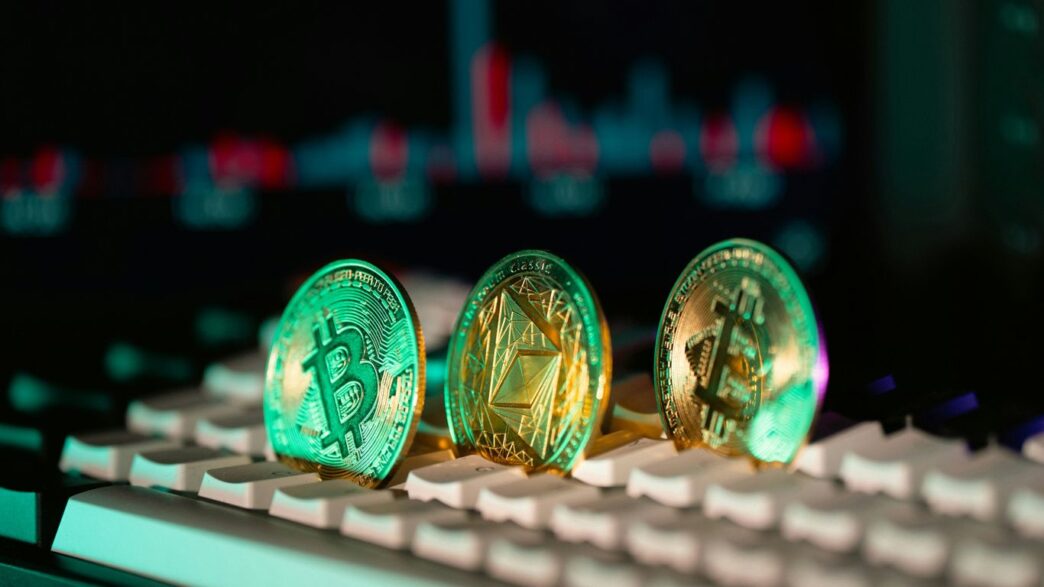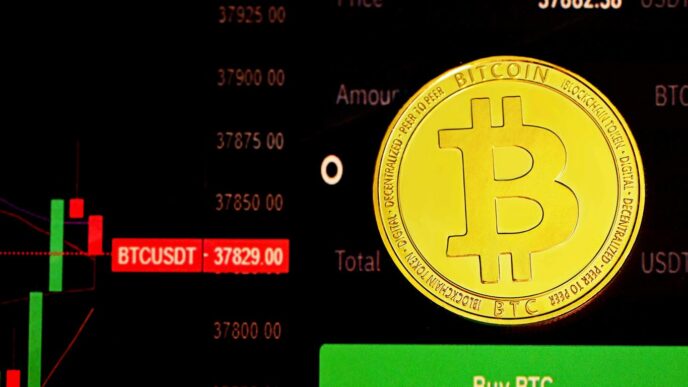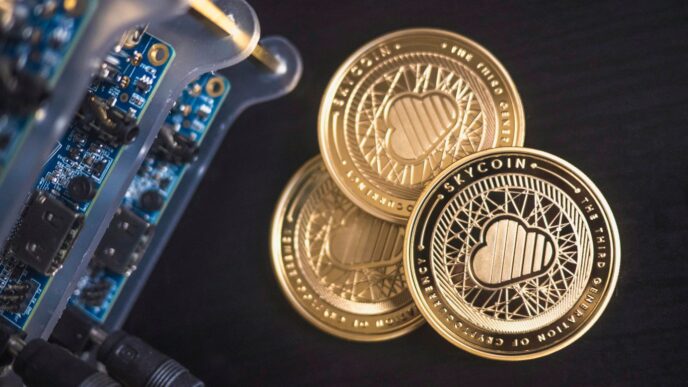Thinking about adding some digital assets to your wallet? It can feel a bit overwhelming with so many options out there. If you’re looking for the best crypto to buy on Coinbase right now, you’re in the right spot. We’ve sifted through the noise to bring you a list of coins that are making waves. Whether you’re new to this or have been around the block, this guide should help you figure out what’s worth your attention.
Key Takeaways
- Institutional interest is growing, with big players investing in major cryptocurrencies like Bitcoin and Ethereum.
- Clearer rules are starting to emerge in the U.S. and globally, which helps traditional investors feel more comfortable.
- New tech is popping up, creating fresh ways to use crypto beyond just trading.
- Some people see Bitcoin as a way to protect their money when the economy is uncertain.
- More people are using crypto daily, with record numbers of active wallets and transactions.
1. Bitcoin
When you’re looking at crypto, Bitcoin (BTC) is pretty much the first thing that comes to mind. It’s been around the longest, since 2009, and it’s still the biggest player out there. Even with all the new coins popping up, Bitcoin holds onto its top spot, mostly because it’s got the largest market value and it’s super easy to buy and sell. Lots of people and big companies are into it.
Think of Bitcoin as digital money. It’s meant to be a way to pay for things and also a way to save your wealth, kind of like digital gold. While it’s used for both, its price swings can make it a bit tricky for everyday shopping. But here’s the thing: there will only ever be 21 million Bitcoins. That scarcity, plus a really dedicated community and the buzz around the recent halving event, keeps it a top pick.
The market has seen some big moves lately, with Bitcoin hitting over $100,000 after the US election, showing a lot of confidence from investors. It’s been trading around that mark, but it’s settled a bit since then. While the network itself hasn’t changed much, news about potential government policies can really shake things up.
Here’s a quick look at some numbers as of today, October 12, 2025:
| Metric | Value |
|---|---|
| Price | $111,835.14 |
| Market Cap | $2.23 Trillion |
| 24h Price Change | -0.04% |
| 7-day Price Change | -9.36% |
| Year-to-Date Return | +19.28% |
What’s keeping Bitcoin strong?
- Market Dominance: It still controls over half the crypto market.
- Institutional Interest: Big players are investing more, partly through new Bitcoin ETFs.
- Regulatory Support: Positive signals from US regulators are helping.
- Upgrades: Ongoing improvements like Taproot are making it better.
- Liquidity: It’s easy to trade large amounts without drastically changing the price.
Recent news also points to a growing acceptance. For instance, a Bitcoin mining company is planning to go public, and a major bank is re-launching its service for big investors to store Bitcoin safely. Plus, with potential interest rate changes from the Federal Reserve, more money might flow into riskier assets like Bitcoin.
2. Ethereum
Ethereum, often seen as the second-biggest cryptocurrency, is a pretty big deal in the digital world. It’s not just about being a currency; it’s more like a platform for all sorts of cool stuff, like decentralized apps and digital art. Think of it as the engine behind a lot of the new things happening in crypto.
Ethereum’s network has been working hard to get faster and cheaper to use. They’ve had a few big upgrades, like the "Merge" and more recently the "Dencun" upgrade, which are supposed to help with those annoying high fees and slow times. Plus, they changed how new coins are made, which can actually make the total supply go down over time. That’s a big change from how it used to be.
Here’s a quick look at some key details:
- Current Price (approx.): $3,830.11 USD
- Market Cap: Over $462 billion
- Key Upgrades: "Merge", "Dencun", and the upcoming "Pectra"
- Use Cases: Powers most decentralized apps (dApps), NFTs, and DeFi protocols.
Lots of other blockchains, called Layer-2 solutions, are built on top of Ethereum. These help make transactions even quicker and cheaper while still using Ethereum’s security. You’ve probably heard of some, like Polygon or Arbitrum. Even Coinbase has its own, called Base.
It’s also one of the only cryptocurrencies, besides Bitcoin, that has its own exchange-traded funds (ETFs) available. People have been buying these ETFs pretty consistently, which shows that bigger investors are getting more interested. You can find more about its current price and market trends on Ethereum price information.
Ethereum is definitely a major player, and it’ll be interesting to see how it keeps up with newer, faster chains popping up.
3. XRP
XRP has been making some serious waves lately, and for good reason. It was built from the ground up to handle money movement – think fast, cheap, and across borders, all without needing a traditional bank in the middle. Transactions can zip through in seconds, and the fees? Barely a penny. It’s like the internet for value, but instead of messages, it’s sending money.
What really sets XRP apart is that it’s not just some new idea; it’s been around for over a decade. It’s got a solid track record of being reliable. Plus, with RippleNet and its On-Demand Liquidity service getting more attention from payment companies and banks, XRP is finding real-world uses.
The regulatory landscape is also looking much clearer for XRP, which is a big deal for investors. The SEC has wrapped up its case, saying XRP isn’t a security in secondary markets. This has removed a lot of the uncertainty that was hanging over it.
Here’s a quick look at some numbers:
| Metric | Value |
|---|---|
| Price (Oct 12, 2025) | $2.40 |
| Market Cap | $239.77B |
| All-Time High | $3.84 |
Of course, like any investment, there are things to watch out for. The price can be a bit jumpy, and Ripple Labs still holds a good chunk of the total supply. Plus, there are always other companies working on similar payment solutions. But overall, the momentum seems to be building, especially with the talk of potential XRP spot ETFs on the horizon.
4. Solana
Solana (SOL) has been making some serious waves in the crypto space, and for good reason. It’s built to be super fast and handle a ton of transactions without costing an arm and a leg. Think of it as a highway for digital stuff, letting things move quickly and cheaply.
This speed and low cost make it a big deal for things like decentralized finance (DeFi), digital collectibles (NFTs), and even high-speed trading platforms. We’re seeing more and more people jump on board because they want faster and cheaper transactions, and that trend seems like it’s only going to keep growing as more uses pop up for the network.
Here’s a quick look at what makes Solana stand out:
- Speed: Solana can process thousands of transactions every second. That’s way faster than many other blockchains out there.
- Low Fees: You won’t pay a fortune to use the network, even when it’s busy. This is a huge plus for everyday users and developers.
- Growing Ecosystem: A lot of new apps and projects are being built on Solana, especially in the DeFi and NFT areas. Plus, there’s a lot of buzz around meme coins on the platform.
- Institutional Interest: Big financial players are starting to pay attention, with some even looking into creating Solana-based exchange-traded funds (ETFs).
While it’s seen some ups and downs in price, like most cryptos, Solana’s underlying technology and the community building on it suggest it’s a strong contender in the blockchain world. It’s definitely one to watch if you’re interested in platforms that prioritize performance and affordability.
5. Dogecoin
Dogecoin, often called the original meme coin, started as a joke but has grown into something much more. It’s built on a system that’s pretty similar to Bitcoin’s, using a Proof of Work model, which keeps it decentralized and open for regular folks to mine. What really makes Dogecoin stand out, though, is its low fees and quick transaction times. This makes it super handy for small payments and, of course, for tipping people online when they share something cool.
The community behind Dogecoin is a huge part of its story, and it’s stayed strong over the years. This ongoing support, along with more and more places starting to accept it as actual money, puts Dogecoin in a good spot for continued interest. It’s not just about the memes anymore; it’s becoming a practical tool for everyday transactions.
Here’s a quick look at some key figures:
- Current Price (as of October 12, 2025): Approximately $0.19
- Market Cap: Around $28.24 billion
- All-Time High: Reached $0.75
- Recent Performance: Saw a drop of about -2.76% in the last 24 hours and -27.41% over the past week.
Traders are keeping an eye on price levels, with some resistance noted around $0.26 to $0.263 and support near $0.256. There’s also buzz about potential ETF approvals that could include Dogecoin, which might shake things up later this month.
6. Cardano
Cardano, often seen as a more academic and research-driven blockchain, aims to provide a secure and sustainable platform for decentralized applications. It uses a proof-of-stake consensus mechanism called Ouroboros, which is designed to be energy-efficient and scalable. The development team focuses heavily on peer-reviewed research, which can mean slower development cycles but potentially a more robust final product.
Cardano’s approach emphasizes methodical progress and security above all else. This has led to a strong community that values its deliberate development path. While it might not always be the fastest to implement new features, the focus on rigorous testing is a key differentiator.
Here’s a quick look at some key aspects:
- Proof-of-Stake: Ouroboros is its unique consensus protocol, designed for security and energy saving.
- Research-Focused: Development is heavily influenced by academic research and peer review.
- Smart Contracts: Cardano supports smart contracts, allowing for the creation of decentralized applications (dApps).
As of today, you can find Cardano (ADA) trading at around CA$0.89 in Canada. The platform continues to evolve, with ongoing updates to its smart contract capabilities and efforts to expand its ecosystem through partnerships. Many see Cardano as a strong contender in the Layer 1 blockchain space, with potential for future growth as its technology matures and adoption increases. Keep an eye on its development updates and ecosystem growth for potential investment insights.
7. Hedera
Hedera is a bit different from your typical blockchain. Instead of a traditional chain, it uses something called Hashgraph. Think of it as a super-fast, super-efficient way to get transactions confirmed. This tech allows Hedera to handle a massive number of transactions every second, and the fees are tiny, usually less than a cent. It’s built with big companies in mind, which is why you see giants like Google, IBM, and Dell working with them on things like tokenizing assets and handling small payments.
Hedera’s focus on enterprise-grade solutions makes it stand out. They’re tackling issues like making sure transactions are ordered fairly and building a network that can grow without getting bogged down. You’re already seeing Hedera’s tech used in areas like central bank digital currencies, tracking goods in supply chains, and even verifying data for AI.
Here’s a quick look at HBAR’s recent performance:
| Metric | Value |
|---|---|
| Price (Oct 12, 2025) | $0.17 |
| Market Cap | $8.61B |
| 24-Hour Change | -2.41% |
| 7-Day Change | -23.07% |
| Year-to-Date Return | -35.72% |
Recently, there’s been some news about the Hashgraph Group releasing a tool called "TransAct." This lets businesses build on Hedera without needing to hold HBAR or even have a crypto wallet, which could open up new possibilities. The price has seen some ups and downs lately, with traders watching closely for any signs of a comeback. It’s an interesting project to keep an eye on, especially if you’re interested in how crypto can be used by large organizations.
8. Bittensor
Bittensor is a pretty interesting project if you’re looking at the whole AI and machine learning space in crypto. It’s basically built to create a decentralized marketplace for AI models. Think of it like this: developers can build AI stuff, and then people can use or even trade these AI models directly on the network. It uses its own token, TAO, to reward everyone involved, from the builders to the users.
The whole idea is to create a collaborative intelligence economy. Since it launched in early 2023, it’s seen some pretty wild growth, going up by a huge percentage. Even though it’s had some ups and downs, like most cryptos, its market cap is still significant, suggesting there’s still room for it to grow.
Here’s a quick look at some numbers for TAO:
| Metric | Value |
|---|---|
| Price (Oct 12, 2025) | $319.54 |
| Market Cap | $6.71B |
| All-Time High | $769.13 |
| 24h Change | -3.34% |
| 7d Change | -1.75% |
| YTD Return | -29.27% |
It’s not on Coinbase yet, which is a bummer if you’re already set up there. But it’s available on other exchanges. The project has been getting some attention, with news about new financial products based on it and even some companies increasing their holdings. It’s definitely one to watch if you’re into the AI crypto trend.
9. Hyperliquid
Hyperliquid is a pretty interesting newcomer in the crypto space, and its token, HYPE, has been one of the top performers this year. Basically, it’s a Layer 1 blockchain built for a fully on-chain financial system. What makes it stand out is its approach to decentralized exchanges (DEXs). Instead of relying on order books that happen off-chain, Hyperliquid keeps everything on-chain. This means more transparency and security for every trade.
The platform is really shaking things up with its gas-free trading for perpetual futures. This is a big deal because it cuts down on costs for users, making it super appealing for both frequent traders and regular folks. They’ve seen some massive growth, with billions in total value locked (TVL) and daily trading volumes that rival some of the biggest players.
Here’s a quick look at what powers the Hyperliquid ecosystem:
- HYPE Token: This is the native token. It gives holders a say in how the platform is run (governance), a cut of the trading fees, and is part of a system designed to reduce the total supply over time.
- On-Chain Order Book: All trading activity is recorded directly on the blockchain, offering a level of trust and verifiability that’s hard to find elsewhere.
- High Performance: Hyperliquid is designed for speed, aiming to offer a trading experience that feels as smooth as what you’d get on a centralized exchange, but with the benefits of decentralization.
It’s worth noting that Hyperliquid has had some significant events, like a large airdrop in late 2024 that distributed millions of HYPE tokens. While the token price has seen some ups and downs since then, with big investors taking notice, there are also discussions about the platform’s level of centralization. Still, its focus on speed, low fees, and a truly on-chain experience makes it a project to watch.
10. Tether
When you’re looking at crypto, especially on an exchange like Coinbase, you’ll notice Tether (USDT) is always around. It’s a stablecoin, which basically means its value is supposed to stay steady, usually pegged to the US dollar. Think of it as a digital dollar in the crypto world.
Tether’s main job is to make trading easier and less risky. Because its price doesn’t swing wildly like other cryptos, people use it to move in and out of trades quickly or to hold value without converting back to traditional money. It’s got a massive market cap and huge daily trading volumes, making it super liquid. You can swap USDT for almost any other crypto on Coinbase almost instantly.
Here’s a quick look at why it’s so popular:
- Stability: It aims to hold a $1 value, which is a big deal in the volatile crypto market.
- Liquidity: You can buy and sell large amounts without drastically affecting the price.
- Trading Pair: It’s used as a base for trading many other cryptocurrencies on exchanges.
- Global Use: It allows for quick, international transfers of value.
Recently, Tether has been making moves, like minting more USDT on Ethereum to meet demand and also exploring ways to integrate more directly with Bitcoin’s network through protocols like RGB. They’ve also been involved in things like aiding fraud investigations by freezing assets, which shows its central role in the financial system. While some people have questions about its reserves, it remains the go-to stablecoin for many traders and investors.
11. Bitcoin Hyper
Okay, so let’s talk about Bitcoin Hyper, or HYPER as you’ll see it. This project is trying to do something pretty interesting: bridge the gap between Bitcoin, the big guy, and the whole world of decentralized finance, or DeFi. Think of it as a Layer-2 network built on top of Bitcoin. The goal is to give Bitcoin holders more options, like earning a bit of yield or using DeFi apps, without having to move their BTC off the main network. It’s a big ambition, for sure.
The idea is to make Bitcoin more useful for everyday financial activities. Right now, Bitcoin is mostly seen as a store of value, but projects like HYPER want to unlock more of its potential. If more people start using Bitcoin for DeFi, it could really change things for the cryptocurrency.
Here’s a quick rundown of what they’re aiming for:
- Faster Transactions: Making it quicker to move Bitcoin around within their ecosystem.
- DeFi Access: Allowing users to interact with decentralized finance applications.
- Yield Opportunities: Giving holders a way to earn returns on their Bitcoin.
- Layer-2 Solution: Building on top of Bitcoin to add these features without changing the core Bitcoin protocol.
It’s still early days, and HYPER is currently in its presale phase. This means you can buy tokens at a lower price before they potentially get listed on exchanges. Given Coinbase’s recent interest in Bitcoin-related Layer-2 solutions, HYPER could be one to watch for a future listing. It’s definitely a project trying to add new functionality to the original cryptocurrency.
12. New Coinbase Listings
Coinbase doesn’t have a set schedule for adding new cryptocurrencies. They tend to list them sporadically, and official announcements usually pop up on their X account, @CoinbaseAssets. It’s a bit of a guessing game, as they keep potential listings pretty quiet beforehand. This secrecy is understandable, especially after past issues with insider trading. So, if you’re looking to get in early, you’ll need to keep a close eye on those announcements.
Getting a new coin listed on Coinbase can really boost its profile and trading activity. Because Coinbase is a big, well-known exchange, especially in the US, a listing often brings a lot of new buyers. This can lead to a quick jump in price right after it’s added. Historically, new listings have seen some pretty impressive gains in their first few days.
If you want to be among the first to know when a new coin is about to hit Coinbase, here are a few things you can do:
- Follow @CoinbaseAssets on X: This is the official channel for announcements. Turn on notifications so you don’t miss anything.
- Set up alerts: Many crypto platforms and news sites offer alerts for new listings. This can help you react fast.
- Research potential candidates: While there’s no official roadmap, keeping an eye on trending projects, those with strong communities, and coins with clear use cases might give you a hint about what could be next.
It’s important to remember that ‘new to Coinbase’ means it’s just been listed and is ready to trade, while ‘upcoming Coinbase listings’ are tokens that are rumored or confirmed to be added soon but aren’t available yet. The crypto world moves fast, and staying informed is key.
Wrapping It Up
So, we’ve looked at some of the top crypto picks available on Coinbase right now. Whether you’re leaning towards the established players like Bitcoin and Ethereum for stability, or eyeing newer projects with growth potential, the key is to do your homework. Remember, the crypto world moves fast, and what looks good today might change tomorrow. Always match your investments to your own financial goals and how much risk you’re comfortable with. Don’t put in more than you can afford to lose, and keep learning. That’s the best way to navigate this exciting, and sometimes wild, market.
Frequently Asked Questions
What’s the best crypto to buy right now?
Right now, XRP is looking like a top pick because many big companies are starting to use it, it has a clear purpose for payments, and its supply is limited. Bitcoin is also a solid choice for long-term safety, and others like Solana and Ethereum are great for different reasons.
Should I buy crypto when the price drops or wait for it to go up?
Buying when the price drops, known as ‘buying the dip,’ can lead to big profits if you guess right, but it’s risky. It’s safer to wait until the price is clearly going up, though you might miss out on some early gains.
Can I make money from my crypto without selling it?
Yes, you can! You can earn extra crypto by ‘staking’ coins like Ethereum, which is like earning interest. You can also lend your crypto to others or provide it for trading on different platforms. Just be aware of the risks involved, like losing your crypto if something goes wrong with the platform.
What’s the safest way to keep my crypto?
The safest way to store your crypto is by using a hardware wallet, which is like a physical USB drive that keeps your digital money offline. This protects it from online hackers. For smaller amounts or if you plan to trade often, a trusted exchange wallet like Coinbase can work, but it’s generally less secure than a hardware wallet.
How do I know if a cryptocurrency is a good investment?
To figure out if a crypto is worth buying, check its important features, like how much it’s used in the real world, how many coins will ever exist, and if it follows the rules. Also, think about if it’s trying to solve a real problem and if it has a strong community supporting it.
What are new Coinbase listings and why are they important?
New Coinbase listings are cryptocurrencies that Coinbase, a major exchange, decides to make available for trading on its platform. Often, when a new crypto gets listed on Coinbase, its price goes up quickly because more people can easily buy and sell it. It’s like a stamp of approval that can bring more attention and money to the project.














